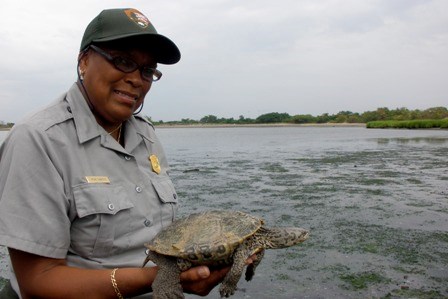
NPS PHOTO Since I have been a TRT at the Jamaica Bay Wildlife Refuge, I have been introduced to many species of fauna and flora. One species that piqued my interest was the diamondback terrapin (Malaclemys terrapin); it is a native species of the bay. I traveled two hours and through four boroughs in New York City to attend an hour and a half ranger-led program on these turtles. Ranger Colleen started the program with a powerful PowerPoint presentation on the terrapins. The PowerPoint addressed many interesting facts about the diamondback terrapin such as images of male and female, habitat in Gateway National Recreation Area (NJ & NYC), nesting areas, shell & skeleton structure, shape and color, related species, eating habits, its life span, its predators, and human interference past and present. After the presentation, she presented a live terrapin for us to observe. This turtle was from the Terrapin Research Program at the wildlife refuge. Colleen reviewed the anatomy using the live terrapin. Then we walked outside along the West Pond trail observing many species of birds and plants. Along the trail, the terrapin was released back in its natural habitat. A few days later while I was at the refuge, an MTA employee called and said he found a diamondback terrapin on the train track east of the East Pond. He brought the turtle by to the visitor center. I was asked to accompany Ranger Julia on a patrol of the North Channel Bridge and while we were on the patrol, we were going to release the terrapin in its natural habitat of the brackish water of the bay. The best place for release for this terrapin was at the beach area north of East Pond of the Jamaica Bay Wildlife Refuge. Once we got to the area that was decided on, we got a big surprise. We found an American white pelican in the midst of a flock of Canada geese and a few great and snowy egrets. I tried to get as close as possible to take pictures without disturbing the birds. In order not to disturb the American white pelican, we traveled to the other side of the beach to release the terrapin and continued with our patrol. Yesterday, Ranger Julia, Nancy (volunteer), Taylor (YCC volunteer) and I were walking along the West Pond trail. This was something I had not done before. Once again the diamondback terrapin appeared. As we were walking along the trail, we observed Terrapin Research volunteers and refuge visitors waving at us. We walked a few feet only to find out that a terrapin was laying her eggs on the side of the trail. We all gave the turtle time to complete her nesting process. Once she was finished, Alex, one of the turtle researchers, marked the nest and checked the turtle. The Diamondback Terrapin Research Program at the wildlife refuge is a research program lead by Dr. Russell Burke, an associate professor of Biology at Hofstra University. His students and volunteers observe, monitor, and collect data associated with the terrapins. They share the tasks, such as gathering data on the existing population as far as their growth or demise, tag them to track and record the movement in the area, and study how the temperature of the protective nesting cages affect the sexual makeup of the young. Protective cages, which are made of different materials, are used to protect the nest and eggs from predators, most often raccoons. Since my new adventure, getting to know the diamondback terrapin, I have received a great lesson on the species, released one, watched nesting, and observed research. Oh! Let's not forget the American white pelican. In my opinion, these turtles are a hardy species. From the time they were hunted by humans for food many years ago to the raccoons that eat their eggs today, they tend to be survivors and thanks to the researchers and volunteers of the Hofstra Research Program at the refuge for helping to protect their nest and eggs from their predators. |
Last updated: February 26, 2015
